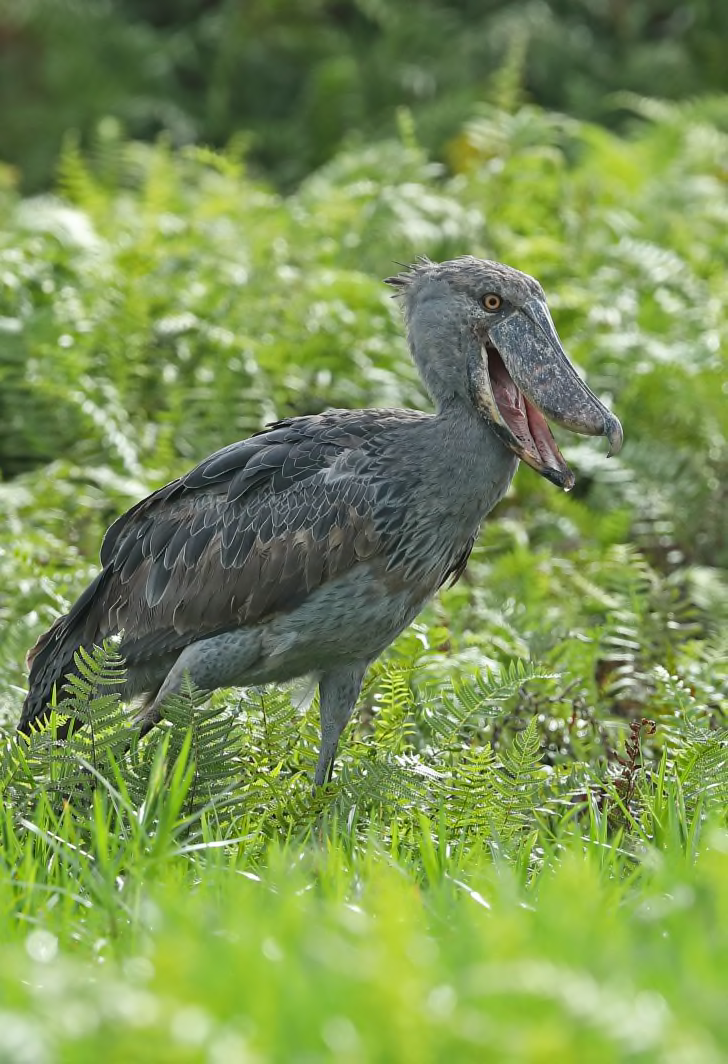

All that is known of Eremopezus is that it was a very large, probably flightless bird with a flexible foot, allowing it to handle either vegetation or prey. It has been suggested that the enigmatic African fossil bird Eremopezus was a relative too, but the evidence for that is unconfirmed. So far, two fossilized relatives of the shoebill have been described: Goliathia from the early Oligocene of Egypt and Paludavis from the Early Miocene of the same country. A 2008 DNA study reinforces their membership of the Pelecaniformes. In 2003, the shoebill was again suggested as closer to the pelicans (based on anatomical comparisons) or the herons (based on biochemical evidence).

Microscopic analysis of eggshell structure by Konstantin Mikhailov in 1995 found that the eggshells of shoebills closely resembled those of other Pelecaniformes in having a covering of thick microglobular material over the crystalline shells. Based on osteological evidence, the suggestion of a pelecaniform affinity was made in 1957 by Patricia Cottam. Traditionally considered as allied with the storks ( Ciconiiformes), it was retained there in the Sibley-Ahlquist taxonomy which lumped a massive number of unrelated taxa into their "Ciconiiformes". The genus name comes from the Latin words balaena "whale", and caput "head", abbreviated to -ceps in compound words. John Gould described it in 1850, giving it the name Balaeniceps rex. The shoebill was known to ancient Egyptians but was not classified until the 19th century, after skins and eventually live specimens were brought to Europe. For real.Molecular studies have found the hamerkop to be the closest relative of the shoebill. They don't say much, in fact they're mute most of the time, but when they clatter their bills upon running into another shoebill, or if it's mating season, duck for cover: It sounds just like a machine gun. Fierce in the wild, the dauntless shoebill has been known to fight Nile crocodiles to get to their delicious babies, and to fraternize with hippos whenever possible, as the sheer enormity of hippos forces yummy shoebill snacks to the water's surface. Stoic loners – there are only about 3,300 to 5,300 individuals left in the wild – the shoebill stays mainly in its own bailiwick, flying (a mere 150 flaps per minute) anywhere from 500 to 1,000 feet (152 to 305 meters) at a time, with most flights in the 65-foot (20-meter) range. While the momma shoebill will lay two or three eggs, only one chick will survive, as the eldest offspring has a Darwinian dark side and, alas, kills its siblings. Both partners participate in building their nest, which is a kind of floating barge that can be as large as 10 feet wide (3 meters) and 9 feet (almost 3 meters) deep. Weighing anywhere from 12 to 15 pounds and standing up to 5 feet (1.5 meters) tall with a wingspan that can reach 8 feet (over 2 meters), this steely-eyed, aloof and gawky bird hangs out in reedy wetlands where it can nosh on its favorite foods, namely lungfish, tilapia, catfish, frogs, snakes, monitor lizards and baby crocodiles – all of which it can snatch and swallow whole or tear through and decapitate easily with its badass, hollow, pelican-like 7-inch (18-centimeter) beak.Ī monogamous bird that can live up to 35 years, the shoebill finds its mate at a young age and aggressively defends its partner against rivals.


 0 kommentar(er)
0 kommentar(er)
